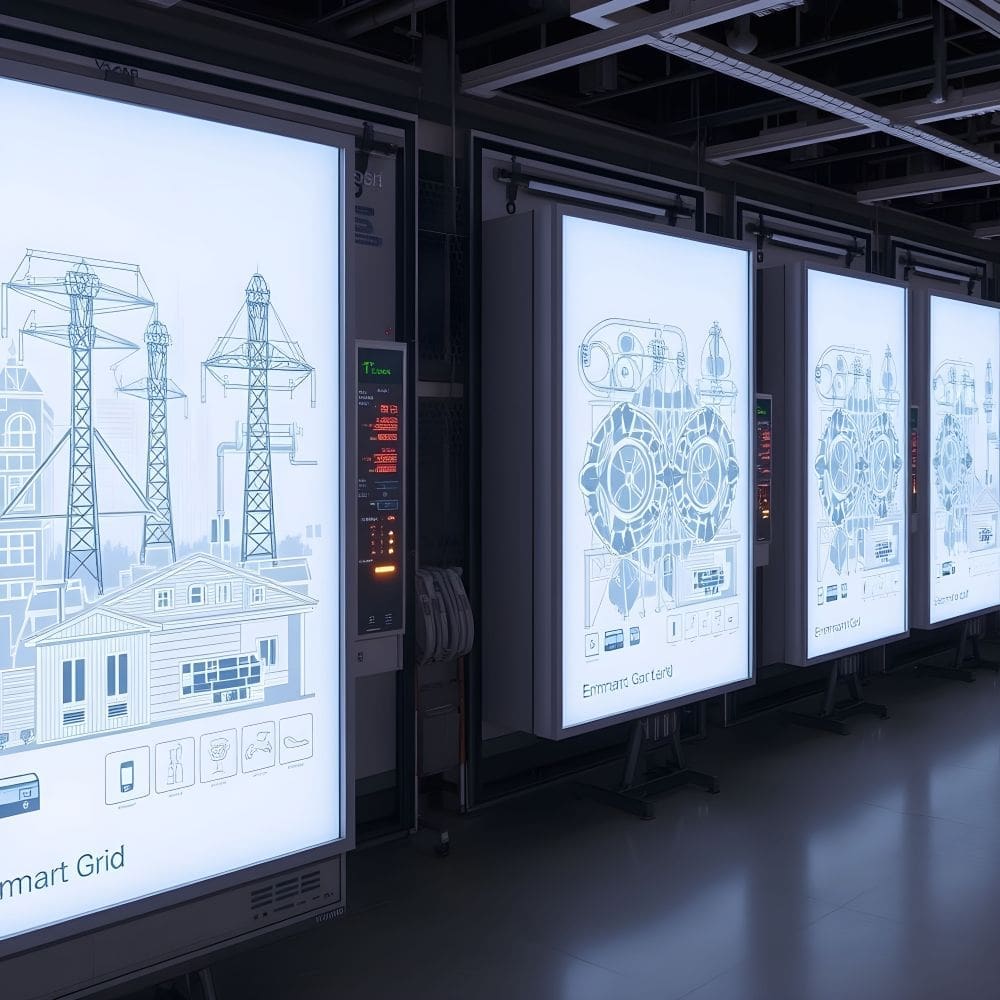Last year, investors poured $1.8 trillion into low-carbon energy transition technologies, which represents a 17% increase from the previous year. The energy investment landscape has changed dramatically as software solutions now take precedence over traditional hardware investments. Climate tech start-ups raised $34.5 billion in 2022, but hardware solutions accounted for only 42% of these funds.
The global energy sector has grown to include more than 72,000 energy-related startups, which shows a clear change in investment priorities. Renewable energy investors now recognize that smart grid technology plays a crucial role in managing energy assets and stabilizing grids. This has led them to move away from conventional fossil fuel investments. These changes reflect a complete restructuring of energy investment strategies, driven by the need to improve efficiency and stability in the clean energy market.
Venture Capital Firms Pour Billions into Grid Modernization
Venture capital firms are investing faster in grid modernization, which signals a major change in the energy investment world. Venture capital invested $2.5 billion into grid research and development in 2022 alone. This amount towers over the $542 million that utilities invested in innovation. The investment gap expresses how external capital drives grid transformation more than traditional utility spending.
Traditional Energy Investors Redirect Capital
Major energy players have created dedicated investment vehicles to tap into the full potential of grid modernization. National Grid Partners, National Grid’s venture capital arm, has invested in 40 companies since it became 5 years old. The $400 million investment arm has generated $80 million in returns for shareholders, though it represents just a fraction of National Grid’s $52.56 billion market cap.
National Grid Partners’ founder explains, “We are not just financial investors. We are a strategic arm of the core business — matchmaking it with leading strategists”. This strategic approach led to investments in companies like LineVision. Their sensor technology helps utilities add 15-40% more capacity to existing transmission lines at just 5% of the new infrastructure’s cost.
Major utilities now follow this path as they see grid modernization as both essential and a valuable chance. These utility-backed venture funds work together instead of competing:
- The U.S. Department of Energy committed $2.2 billion to grid infrastructure through its Grid Resilience and Innovation Partnerships program
- The European Union wants to invest $633 billion by 2030, with $184 billion earmarked for grid digitalization
- China’s State Grid Corporation announced investments of $77 billion in transmission for 2023 alone
- Japan has launched a $155 billion funding program for new grid technologies
This shared approach makes strategic sense because regulated utilities rarely compete against each other. The result is quicker adoption of promising technologies across the industry. These investments also help “de-risk” the sector for other investors and create a flywheel effect of incoming capital.
Record-Breaking Q2 Funding Rounds Revolutionize the Market
Smart grid companies attracted unprecedented funding in 2023’s second quarter. They secured $4.9 billion across 32 deals, showing a remarkable 126% increase quarter-over-quarter and a 67% increase year-over-year. Corporate funding for smart grid companies reached $1.8 billion in 2023’s first half, marking a 64% increase from 2022’s same period.
Smart grid companies’ venture capital funding grew 32% during this time. Investors put $986 million in the first half of 2023. Notable deals included Driveco securing $273 million, Jolt Energy receiving $162 million, and SPAN acquiring $96 million.
This investment surge has altered market projections significantly. The global smart grid market, valued at $40.61 billion in 2023, should reach between $203.92 billion and $237.16 billion by the early 2030s. This represents a compound annual growth rate of about 19%.
These record-breaking funding rounds show growing investor confidence in the sector’s potential returns. Smart grid modernization technologies continue to prove their value, leading to a fundamental shift of capital from traditional energy assets toward reliable, resilient infrastructure solutions.
Why Investors Abandon Fossil Fuels for Smart Grid Solutions
The failing aging power infrastructure has become a key factor that pushes investment dollars away from fossil fuels toward smart grid technologies. Department of Energy data shows at least 175 physical attacks or threats against critical grid infrastructure in 2023 alone. Among other security concerns, Check Point Research recorded 1,162 cyberattacks on utilities in 2024—a 70 percent increase from the previous year.
Grid Failures Expose Critical Infrastructure Vulnerabilities
Power grid vulnerabilities go way beyond the reach and influence of isolated outages and threaten multiple interdependent systems. Extended power outages can lead to critical infrastructure collapse in water systems, telecommunications, food production, healthcare, and financial networks. The North American Electric Reliability Corporation (NERC) reports grid susceptibility points growing by about 60 per day. This makes modernization investment a necessity.
“We never predicted that our critical infrastructure control systems would be facing advanced levels of malware,” said Jon Wellinghoff, former chairman of the Federal Energy Reserve Commission. This reality has made energy investors focus on technologies that boost reliability and security while reducing dependence on centralized fossil fuel generation.
Decarbonization Mandates Drive Urgent Capital Reallocation
International decarbonization policies speed up capital changes toward grid modernization. Clean energy investment will top USD 3 trillion in 2024, with the ratio between clean energy and fossil fuels now at 2:1, according to the International Energy Agency. Yet this falls short of the USD 5.6 trillion yearly investment needed between 2025 and 2030 to achieve net zero emissions by 2050.
Local mandates work best at driving investment reallocation, especially when you have specific requirements. New York City’s Local Law 97 will affect about 50,000 properties with greenhouse gas emission limits next year. Non-compliance penalties will cost USD 268 per metric ton of excess carbon. Blackstone has already committed USD 15 billion to invest in and lend to renewable energy firms.
Industry analysts note that “The era of voluntary green building standards is likely ending” as 35 of the 50 largest U.S. cities have adopted local climate action plans. These regulatory frameworks give grid technology investors unprecedented certainty.
Return on Investment Outpaces Traditional Energy Assets
Smart grid technologies are a great way to get financial returns that traditional fossil fuel investments can’t match. The Brattle Group’s research shows distributed energy resources (DERs) could save more than USD 23 billion in costs over the coming decades. These technologies deliver key benefits:
- Better grid utilization and reliability
- Consumer strength and demand response
- Easier integration of renewable energy sources
- Less energy waste (traditional grids lose up to 8% during transmission)
The financial benefits stand out clearly. Traditional grid spending stayed flat at USD 300 billion yearly between 2015 and 2021, but investment should reach USD 400 billion in 2024. Battery storage investments keep growing and should hit USD 54 billion this year.
DERs solve distribution system planning challenges and improve resilience when fully applied. This explains why renewable energy investors now see grid connection and management solutions as vital portfolio components rather than optional add-ons.
Smart grid technology investments keep showing better returns while addressing security vulnerabilities and regulatory requirements. This makes the investment case for traditional fossil fuels harder to justify.
How Software Startups Capture the Lion’s Share of New Funding
Software solutions are taking over hardware investments in the smart grid technology market. Both segments saw increased funding, but smart grid software startups have emerged as clear winners in getting investor dollars.
AI-Powered Grid Management Platforms Attract Premium Valuations
AI integration has become the key factor in securing valuable funding rounds. National Grid Partners has set aside $100 million for AI startups working on energy solutions. They have already invested $150 million in 18 AI-focused startups—making up 37% of their portfolio. This focus on intelligence over infrastructure shows results. AiDASH’s deployment in Massachusetts cut power outages by 30% by using AI to spot dangerous trees near power lines.
London’s smart grid deeptech Ionate shows this trend well. The company secured $17 million in Series A funding for its AI-powered Aurora software platform. This investment came even as total smart grid technology funding dropped from $2.7 billion to $1.1 billion. It shows how AI capabilities attract premium valuations, whatever the market conditions.
David Grimm, Partner at AlbionVC, explains this trend: “In a grid infrastructure market dominated by a handful of entrenched players, investors appear likely to continue favoring those with a repeatable go-to-market strategy and demonstrable market traction”.
VCs Favor Capital-Efficient SaaS Models Over Hardware Plays
SaaS business models have become the top choice for grid modernization investments. Recent data shows about 30 energy management software startups got funding between 2023 and early 2024. Only 19 hardware-focused startups received funding in the same period.
SaaS models offer better financial efficiency. These businesses can turn every dollar spent on sales into equivalent recurring revenue in less than a year. This creates ongoing growth opportunities that hardware companies can’t match. These companies often get valuations of 10-20 times their annual revenue, making them more appealing to venture capitalists.
KrakenFlex CEO Devrim Celal points out the key benefits: “In the ‘old world’, massive power plants came with extremely customized software systems that are no longer fit for purpose. In the ‘new world’, the SaaS model works well as it doesn’t require a big upfront capital expenditure, its costs can be scaled with the adoption of renewables, and it can be updated regularly”.
Numbers back up this change. The broader SaaS market grew by 550% from 2015 to 2022, jumping from $31.4 billion to $172 billion. VC funding for energy efficiency companies surged to $1.5 billion—almost four times higher. Smart grid companies saw their funding rise by 26% to $530 million.
Energy management startups using SaaS models attract investors by offering both tech advancement and better financial efficiency. Traditional energy investments find it hard to compete with this combination.
Which Smart Grid Technologies Command the Highest Valuations
Four categories stand out in the smart grid technology ecosystem. These frontrunners capture investor attention and command premium valuations.
Demand Response Solutions Lead Investment Growth
Demand response programs give consumers incentives to adjust their electricity usage during peak periods. The global demand response management system market reached $10.47 billion in 2024. Experts project it to grow at a 15.8% CAGR through 2030. These solutions help electricity providers balance supply and demand effectively. The smart demand response market should expand from $36.33 billion in 2025 to $59.16 billion by 2029, with a 13% CAGR.
Grid-Scale Battery Management Systems Secure Major Funding
Battery storage technologies now attract record investments. Form Energy made headlines by securing $147 million for an 85MW iron oxide battery system. This system’s 100-hour duration (8,500MWh) makes it the largest battery storage project announced so far. The Department of Energy supports this sector with $41.25 million in funding for grid-scale energy storage systems.
Predictive Maintenance Platforms Emerge as Investor Favorites
Predictive maintenance platforms deliver concrete ROI and command high valuations. Companies using these systems cut maintenance costs by up to 30%. The technology reduces machine downtime by 30-50% and extends equipment life by 20-40%. Utilities find this appealing as they try to maximize their critical infrastructure assets’ lifespan.
Virtual Power Plant Orchestrators Attract Strategic Investors
VPP orchestrators have become investment magnets. These platforms combine distributed energy resources like rooftop solar and battery storage. They could help utilities save about $10 billion in annual grid costs. ConEd’s real-life application proves this value. They deployed a 5MW battery storage project for $200 million instead of choosing a $2 billion infrastructure option.
Energy investors now focus their capital on grid modernization. These four technology categories have become the most valuable parts of tomorrow’s intelligent energy ecosystem.
Renewable Energy Investors Shift from Generation to Integration
The renewable energy investment world has seen a radical alteration as money flows toward technologies that merge with power systems rather than just generate clean power. Investors no longer focus on building more wind farms or solar arrays. They are now trying to solve the problem of connecting these resources to existing power systems.
Solar and Wind Investors Pivot to Grid Connection Technologies
The main obstacle to renewable energy expansion turns out to be insufficient grid capacity. There are 2,600 gigawatts of generation and storage capacity stuck in interconnection queues. This massive backlog is twice the total installed capacity of the U.S. power plant fleet. Investment has shifted to tackle this connection crisis, and grid investments grew by 8% in 2022 alone.
Power grids must expand substantially to meet the growing electricity needs. Net-zero emissions by 2050 would require doubling infrastructure investment to €550 billion per year by 2030. This reality led utility giants like National Grid to completely change their investment approach. The company sold its U.S. renewables business to Brookfield Asset Management and now focuses only on network infrastructure.
Energy Storage Funding Transitions from Batteries to Software Control
While physical connections pose challenges, money has started flowing toward software solutions that optimize energy storage performance. Energy storage enables clean energy transition, and software, without a doubt, powers energy storage. The Department of Energy recognized this change and allocated $125 million to support energy storage research.
Battery analytics and intelligence platforms are attracting substantial investment. These platforms give operators crucial information about temperature, cycling rates, and overall battery degradation. The business case makes sense – software maximizes battery ROI without needing “gigafactories to scale”.
This move toward software-based solutions matches market forecasts. The smart grid market will grow from $73.85 billion in 2024 to $161.15 billion by 2029, showing a 16.9% CAGR. Smart grid technologies will end up saving over $290 billion in global energy costs by 2029. This explains why renewable energy investors now focus on grid connection and integration instead of just adding more generation capacity.
Conclusion
Smart grid technology leads today’s energy investment strategy and marks a decisive transformation in capital flow through the power sector. Traditional energy investors now see grid modernization as an urgent necessity and a great chance to invest. AI-powered grid management and SaaS platforms attract premium valuations that offer better returns than conventional infrastructure investments.
Market projections tell a compelling story. Smart grid technologies could save $290 billion in global energy costs by 2029. These numbers show why venture capital firms, utilities, and traditional energy investors now direct much of their capital toward grid innovation instead of conventional power generation. They focus on four groundbreaking technologies: solutions that just need responses, battery management systems, predictive maintenance platforms, and virtual power plant orchestrators.
This transformation shows that the energy transition’s success depends on more than building renewable capacity. The sector just needs intelligent systems to manage, store, and distribute clean power well. Smart grid technologies will continue to attract substantial capital and revolutionize global energy infrastructure, based on current investment trends and regulatory pressures.





